Related Research Articles
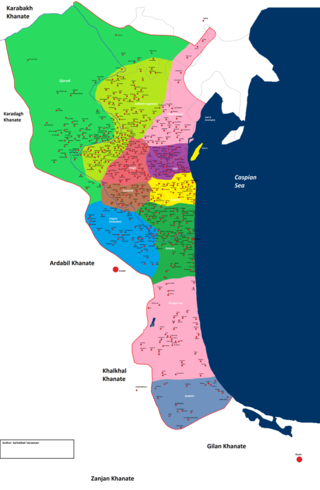
Talysh Khanate or Talish Khanate was an Iranian khanate of Iranian origin that was established in Afsharid Persia and existed from the middle of the 18th century till the beginning of the 19th century, located in the south-west coast of the Caspian Sea.

The Shaki Khanate was a khanate under Iranian and later Russian suzerainty, which controlled the town of Shaki and its surroundings, now located in present-day Azerbaijan.

Shirvan Khanate was a Caucasian khanate under Iranian suzerainty, which controlled the Shirvan region from 1761 to 1820.
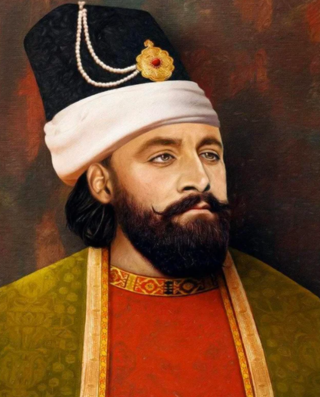
Panah Ali Khan Javanshir was the founder and first ruler of the Karabakh Khanate under Persian suzerainty.
Javad Khan Qajar was a member Ziyadoghlu Qajar, a clan of the Qajar tribe, as well as the sixth and the last khan of the Ganja Khanate from 1786 to 1804 before it was lost to Russia.

Qalaqayın is a village and the most populous municipality, except for the capital Sabirabad, in the Sabirabad Rayon of Azerbaijan. It has a population of 7,658.
The fortress of the historic Javad Khanate and the center of the Mughan district.
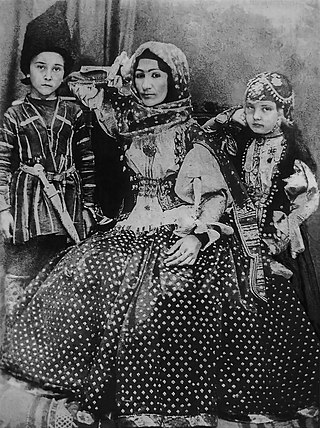
The Javanshirs are a Turkic clan from Karabakh, who are a branch of the Oghuz Turks. Between 1748 and 1822, members of the Javanshir clan functioned as the head of the Karabakh Khanate.
Gazikumukh Khanate was a Lak state that was established in present-day Dagestan after the disintegration of Gazikumukh Shamkhalate in 1642. Its peoples included various Lezgin tribes and Avars.
Fatali Khan or Fath Ali Khan of Quba was a khan of the Quba Khanate (1758–1789) who also managed to dominate the Derbent, Baku, Talysh and Shirvan Khanates, as well as the Salyan Sultanate during much of his reign.

The Derbent Khanate was a Caucasian khanate that was established in Afsharid Iran. It corresponded to southern Dagestan and its center was at Derbent.
Hajji Mohammad Ali Khan was the first khan (governor) of the Shirvan Khanate, ruling from 1761 to 1763. With the permission of the Zand ruler Karim Khan Zand, he was put in power by the inhabitants of Old Shamakhi. He governed Shirvan until 1763, when Fath-Ali Khan of Quba gained influence there, and appointed his own governors, such as Aghasi Beg and Askar Beg, both members of the same family.
Aghasi Khan (1731–88) was second Khan of Shirvan Khanate along with his brother Muhammad Said Khan. He was of nomadic tribe of Khanchobani.
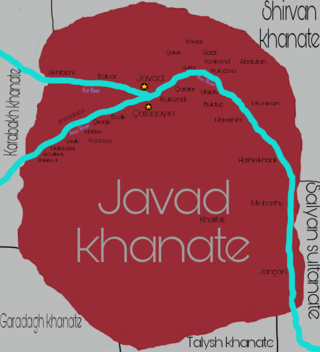
Javad Khanate was a khanate in the territory of modern Azerbaijan with its capital in the town of Javad. It extended from Javad on the Kura River southwest along the east side of the Aras River. It was bordered by Shamakhy Khanate (north), Karabakh Khanate (west), Karadagh khanate (southwest), Talysh Khanate (south), and Salyan Sultanate (east).
Mostafa Khan was the last khan of Shirvan, until 1820.
Malik Muhammad Khan was second khan of Baku and a son of Mirza Muhammad Khan.
Muhammad Husayn Khan Mushtaq, was the third khan of Shaki. He was described as a courageous but ruthless man by Abbasgulu agha Bakikhanov.
Jamal al-Din Khan was the first khan of the Talysh Khanate under Iranian suzerainty, ruling from 1747 to 1786.
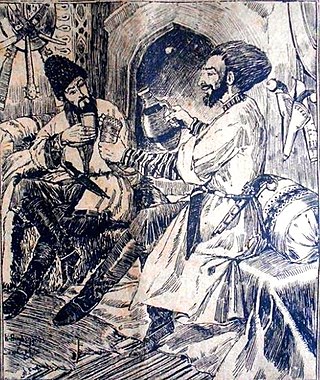
Umma Khan V Avar nicknamed Great or Mad — Avar nutsal, ruler of Avar Khanate from 1774 to 1801. Under Khan, the Avar Khanate expanded its borders both by subordinating the Avar free societies, and at the expense of neighboring territories. Khan was paid tributes by the Georgian king Erekle II, Derbent, Quba, Baku, Shirvan, Shaki khans and Akhaltsikhe pasha.

Amir Hamza III was an khan of Kaitags who ruled Kaitag Utsmiate from 1751 to 1787. He was known as a significant military figure in the history of Dagestan and Transcaucasia in the 18th century.
Surkhay Khan Kun-Butta or erroneously Khanbutai, Khon-Butai, Khomutai was an 18th-century Dagestani military leader as well as last independent Gazikumukh Khan.